#legionary extraordinary
Text
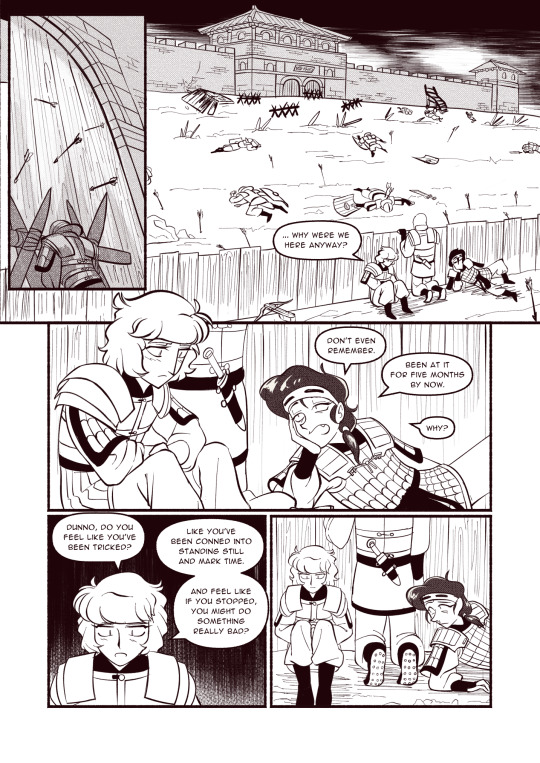





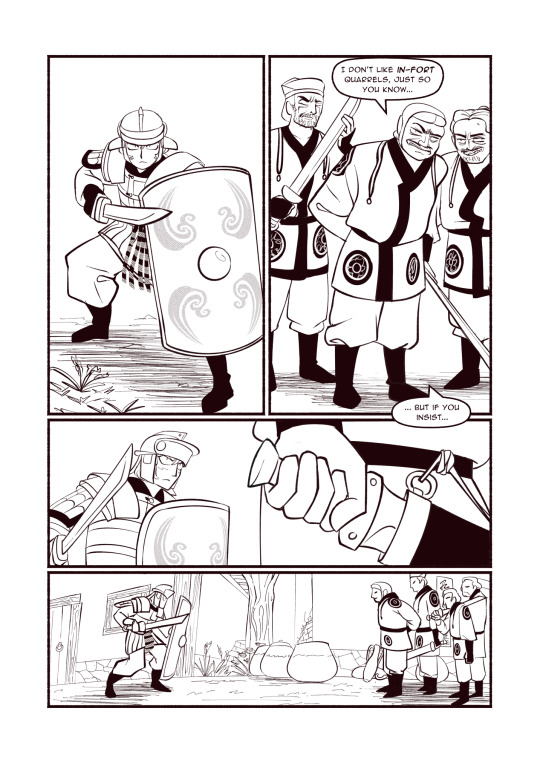

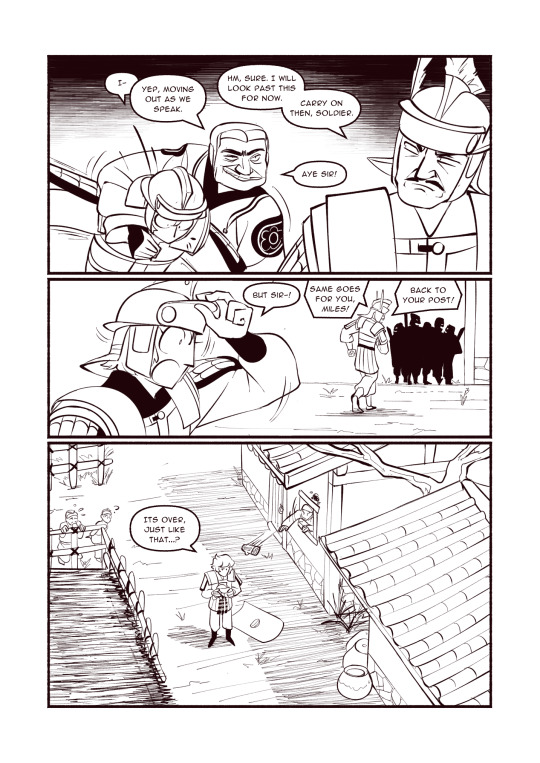
"Besieged"
A Legionary Extraordinary short comic I made a while ago on my patreon, now uploaded here so I have a Yedocia related thing before the year is over
135 notes
·
View notes
Text
Ancient Roman refrigerator discovered in military barrack with preserved bones: Shrouded in mystery
A Roman-constructed meals storage container that served as a primitive fridge for touring troopers was lately found in Bulgaria by Polish archeologists.
Lead archeologist, Piotr Dyczek, a professor on the College of Warsaw Antiquity of Southeastern Europe Analysis Centre, uncovered the traditional fridge at an excavation web site situated close to the city of Svishtov, in line with a report from Science in Poland – a science information outlet run by the Polish Press Company.
The excavation web site was Novae – a legionary fortress of the Roman Empire that was inbuilt northern Bulgaria on the Danube River.
ANCIENT CEREMONIAL CHARIOT EXCAVATED IN POMPEII: ‘EXTRAORDINARY FIND’
Archeologists excavated the fridge from the fortress’s Sector XII on Friday, Oct. 7, a web site picture exhibits, in line with FOX 11 Los Angeles.
An historical Roman “fridge” was present in Bulgaria on the Novae legionary fortress by Polish archeologists in October 2022.
(Piotr Dyczek)
Contained in the fridge, Dyczek and his crew reportedly discovered ceramic plates, dish fragments and animal bones.
The archeologists examined the “preserved bone fragments” and located “traces of thermal remedy,” which possible means the meat saved within the fridge was baked, in line with Science in Poland.
LOS ANGELES MUSEUM RETURNS ‘ILLEGALLY EXCAVATED’ ITALIAN ART TO MINISTRY
Different artifacts the crew discovered have been cash, wall strings, quern-stones, weaving and fishing weights, spindle whorls, pits with bone and vessel fragments, charcoal particles, a bowl fragment and an incense container that will have been used to repel bugs, the science outlet reported.
The traditional fridge reportedly stands out as a result of the storage containers not often survive constructing reconstructions, Dyczek advised Science in Poland.
Ruins of the traditional Roman fortress Novae stay standing in Bulgaria. The fortress was constructed hundreds of years in the past close to the Danube River.
(iStock)
Historic information present Roman troopers have been stationed at Novae from the primary century A.D. till the mid-fifth century A.D.
WORLD’S OLDEST SHARK VICTIM ON RECORD GETS DECODED BY SCIENTISTS
“At the moment, Novae was slowly reworking right into a civilian metropolis,” mentioned Dyczek, in a press release. “Additionally because of the newest finds, we obtained sufficient knowledge to have the ability to recreate that a part of the historical past of this historical settlement, which till now was shrouded in thriller.”
The traditional Roman fridge is certainly one of many discoveries Polish archeologists have made in Novae.
Partitions and columns are nonetheless standing on the historical Roman fortress Novae, which is situated close to the city of Svishtov (Bulgarian for “candle”) in Bulgaria.
(iStock)
Researchers have discovered fragments of ceramic and lead pipe water provide techniques within the space that may’ve been used for thermal baths, Science in Poland reported.
CLICK HERE TO GET THE FOX NEWS APP
An approximate 6.2-mile aqueduct and two massive water tanks are believed to have supplied the Bulgarian-based Roman military uninterrupted entry to water.
Cortney Moore is an affiliate way of life author on the Way of life crew at Fox Information Digital.
Originally published at SF Newsvine
0 notes
Text
Gaius julius caesar documentary

#Gaius julius caesar documentary trial
Marc Antony was a problem for another day. To murder the man whose power and position were eroding the ideas of the Republic. Their sole aim was to kill Caesar, the dictator. But Marcus Brutus, according to the likes of Appian and Cassius Dio, convinced them not to. Interestingly, some of the conspirators, such as Cassius, had wanted to kill Marc Antony along with Caesar at the senate meeting. Sit back, relax, and let us take you on a journey back to Rome on the Ides of March 44BC. Soon after, Caesar would enter the meeting room and be greeted by a bloody coup. It was his mission to separate Marc Antony from Caesar. But like Decimus, he too had grown disillusioned with Caesar, he too had joined the conspiracy against the dictator. He had served alongside Caesar, Marc Antony and Decimus Brutus since the Gallic Wars. Trebonius was another longstanding ally of Caesar. It was there that Gaius Trebonius, an old ally of Marc Antony, pulled the consul aside to discuss some pressing matters. But outside the Theatre, his and Caesar’s paths would diverge. At that time, Marc Antony held the office of consul: he was one of the most powerful men in Rome beneath Caesar, and had intended to attend the meeting. Marc Antony, Caesar’s right-hand man, did not accompany Caesar into the meeting. The Senate meeting room was situated in the Theatre of Pompey, which itself was located in the Campus Martius, one of the key centres of ancient Rome. This is the story of how the most famous assassination in ancient history unfolded. In the Senate, Pompey must defend the prolonged absence of his friend and co-Consul Caesar against charges of corruption.In the afternoon of 15 March 44 BC, the Roman dictator Gaius Julius Caesar entered the Senate meeting room where he met his doom. He's saddened however when he receives news from his good friend Pompey Magnus that his daughter, Pompey's wife, has died in childbirth. With his campaign in Gaul coming to a successful conclusion, Caesar's popularity is continuing to grow. 'The Stolen Eagle.' In Gaul in 52 B.C., two Roman soldiers, Legionary Titus Pullo and Centurion Lucius Vorenus, are tasked with recovering Julius Caesar's personal Eagle, stolen from his camp in the dead of night. In this historical drama, the turbulent transition from Roman republic to autocratic empire, which changed world history through civil war and wars of conquest, is sketched both from the aristocratic viewpoint of Julius Caesar, his family, his adopted successor Octavian Augustus, and their political allies and adversaries, and from the politically naive viewpoint of a few ordinary Romans, notably the soldiers Lucius Vorenus and Titus Pullo and their families. In the process, she reveals a more intriguing portrait of not just the monster, but the man. Above all, she explains why Caligula has ended up with such a seemingly unredeemable reputation. Piecing together the evidence, Mary puts Caligula back into the context of his times to reveal an astonishing story of murder, intrigue and dynastic family power.
#Gaius julius caesar documentary trial
Such as in the extraordinary luxury of his private yachts outside Rome in the designs he chose for his coins when he became Emperor in an eye-witness account of Caligula's withering humour written in 41AD the trial documents covering the mysterious death of his father when he was just seven-years-old and even in a record of his imperial slaves - from the palace spy to his personal trainer. Some stories are difficult to get to the bottom of as they were written by hacks long after his death, but there is plenty of surviving evidence where the 'real' Caligula can be glimpsed. All that in just four short years in power before a violent and speedy assassination in a back alley of his own palace at just 28-years-old." But how much of his story is true? Travelling across the Roman world - from Germany and Capri in the bay of Naples to the astonishing luxury of his life in imperial Rome - Mary attempts to peel away the myths. He was said to have made his horse a consul, proclaimed himself a living God, and indulged in scandalous orgies - even with his own three sisters - and that's before you mention building vast bridges across land and sea, prostituting senators' wives and killing half the Roman elite seemingly on a whim. Caligula has now become known as Rome's most capricious tyrant, and the stories told about him are some of the most extraordinary told about any Roman emperor. Professor Mary Beard embarks on an investigative journey to explore the life and times of Gaius Julius Caesar Augustus Germanicus - better known to us as Caligula. Two thousand years ago one of history's most notorious individuals was born.

0 notes
Text
Anonymous asked: I noticed you did post to acknowledge the death of Uderzo, the co-creator of the Asterix comics. I have to ask Tintin or Asterix? Which one do you prefer?
It’s like asking Stones or Beatles? I love both but for different reasons. I would hate to choose between the two.
Both Tintin and Asterix were the two halves of a comic dyad of my childhood. Whether it was India, China, Hong Kong, Japan, or the Middle East the one thing that threads my childhood experience of living in these countries was finding a quiet place in the home to get lost reading Asterix and Tintin.
Even when I was eventually carted off to boarding school back in England I took as many of my Tintin and Asterix comics books with me as I could. They became like underground black market currency to exchange with other girls for other things like food or chocolates sent by parents and other illicit things like alcohol. Having them and reading them was like having familiar friends close by to make you feel less lonely in new surroundings and survive the bear pit of other girls living together.
If you asked my parents - especially my father - he would say Tintin hands down. He has - and continues to have in his library at home - a huge collection of Tintin comic books in as many different language translations as possible. He’s still collecting translations of each of the Tintin books in the most obscure languages he can find. I have both all the Tintin comic books - but only in English and French translations, and the odd Norwegian one - as well as all the Asterix comic books (only in English and French).
Speaking for myself I would be torn to decide between the two. Each have their virtues and I appreciate them for different reasons.

Tintin was truly about adventure that spoke deeply to me. Tintin was always a good detective story that soon turned to a travel adventure. It has it all: technology, politics, science and history. Of course the art is more simpler, but it is also cleaner and translates the wondrous far-off locations beautifully and with a sense of awe that you don’t see in the Asterix books. Indeed Hergé was into film-noir and thriller movies, and the panels are almost like storyboards for The Maltese Falcon or African Queen.
The plot lines of Tintin are intriguing rather than overly clever but the gallery of characters are much deeper, more flawed and morally ambiguous. Take Captain Haddock I loved his pullover, his strangely large feet, his endless swearing and his inability to pass a bottle without emptying it. He combined bravery and helplessness in a manner I found irresistible.

I’ve read that there is a deeply Freudian reading to the Tintin books. I think there is a good case for it. The Secret of the Unicorn and Red Rackham's Treasure are both about Captain Haddock's family. Haddock's ancestor, Sir Francis Haddock, is the illegitimate son of the French Sun King – and this mirrors what happened in Hergé's family, who liked to believe that his father was the illegitimate son of the Belgian king. This theme played out in so many of the books. In The Castafiore Emerald, the opera singer sings the jewel song from Faust, which is about a lowly woman banged up by a nobleman – and she sings it right in front of Sir Francis Haddock, with the captain blocking his ears. It's like the Finnegans Wake of the cartoon. Nothing happens - but everything happens.
Another great part is that the storylines continue on for several albums, allowing them to be more complex, instead of the more simplistic Asterix plot lines which are always wrapped up nicely at the end of each book.

Overall I felt a great affinity with Tintin - his youthful innocence, wanting to solve problems, always resourceful, optimistic, and brave. Above all Tintin gave me wanderlust. Was there a place he and Milou (Snowy) didn’t go to? When they had covered the four corners of the world Tintin and Milou went to the moon for heaven’s sake!

What I loved about Asterix was the style, specifically Uderzo’s visual style. I liked Hergé’s clean style, the ligne claire of his pen, but Asterix was drawn as caricature: the big noses, the huge bellies, often being prodded by sausage-like fingers. This was more appealing to little children because they were more fun to marvel at.
In particular I liked was the way Uderzo’s style progressed with each comic book. The panels of Asterix the Gaul felt rudimentary compared to the later works and by the time Asterix and Cleopatra, the sixth book to be published, came out, you finally felt that this was what they ought to look like. It was an important lesson for a child to learn: that you could get better at what you did over time. Each book seemed to have its own palette and perhaps Uderzo’s best work is in Asterix in Spain.
I also feel Asterix doesn’t get enough credit for being more complex. Once you peel back the initial layers, Asterix has some great literal depth going on - puns and word play, the English translation names are all extremely clever, there are many hidden details in the superb art to explore that you will quite often miss when you initially read it and in a lot of the truly classic albums they are satirising a real life country/group/person/political system, usually in an incredibly clever and humorous way.
What I found especially appealing was that it was also a brilliant microcosm of many classical studies subjects - ancient Egypt, the Romans and Greek art - and is a good first step for young children wanting to explore that stuff before studying it at school.
What I discovered recently was that Uderzo was colour blind which explains why he much preferred the clear line to any hint of shade, and it was that that enabled his drawings to redefine antiquity so distinctively in his own terms. For decades after the death of René Goscinny in 1977, Uderzo provided a living link to the golden age of the greatest series of comic books ever written: Paul McCartney to Goscinny’s John Lennon. Uderzo, as the Asterix illustrator, was better able to continue the series after Goscinny’s death than Goscinny would have been had Uderzo had died first, and yet the later books were, so almost every fan agrees, not a patch on the originals: very much Wings to the Beatles. What elevated the cartoons, brilliant though they were, to the level of genius was the quality of the scripts that inspired them. Again and again, in illustration after illustration, the visual humour depends for its full force on the accompaniment provided by Goscinny’s jokes.
Here below is a great example:
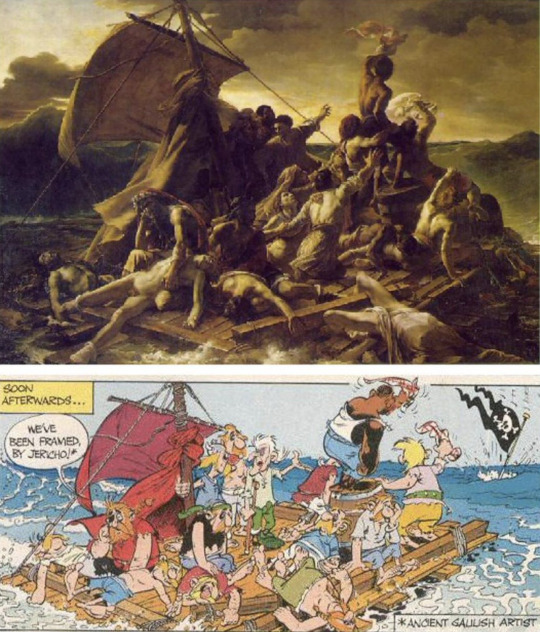
There’s a lot of genius in this. Uderzo copied Theodore Géricault’s iconic ‘Raft of the Medusa’ 1818 painting in ‘Asterix The Legionary’. The painting is generally regarded as an icon of Romanticism. It depicts an event whose human and political aspects greatly interested Géricault: the wreck of a French frigate, Medusa, off the coast of Senegal in 1816, with over 150 soldiers on board. But Anthea Bell’s translation of Goscinny’s text (including the pictorial and verbal pun ‘we’ve been framed, by Jericho’) is really extraordinary and captures the spirit of the Asterix cartoons perfectly.
This captures perfectly my sense of humour as it acknowledges the seriousness of life but finds humour in them through a sly cleverness and always with a open hearted joy. There is no question that if humour was the measuring yard stick then Asterix and not Tintin would win hands down.
It’s also a mistake to think that the world of Asterix was insular in comparison to the amazing countries Tintin had adventures. Asterix’s world is very much Europe.
Every nationality that Asterix encounters is gently satirised. No other post-war artistic duo offered Europeans a more universally popular portrait of themselves, perhaps, than did Goscinny and Uderzo. The stereotypes with which he made such affectionate play in his cartoons – the haughty Spaniard, the chocolate-loving Belgian, the stiff-upper-lipped Briton – seemed to be just what a continent left prostrate by war and nationalism were secretly craving. Many shrewd commentators believe that during the golden age when Goscinny was still alive to pen the scripts, that it was a fantasy on French resistance during occupation by Nazi Germany. Uderzo lived through the occupation and so there is truth in that. Perhaps this is why the Germans are the exceptions as they are treated unsympathetically in Asterix and the Goths, and why quite a few of the books turn on questions of loyalty and treachery.

Even the British are satirised with an affection that borders on love: the worst of the digs are about our appalling cuisine (everything is boiled, and served with mint sauce, and the beer is warm), but everything points to the Gauls’ and the Britons’ closeness. They have the same social structure, even down to having one village still holding out against the Romans; the crucial and extremely generous difference being that the Britons do not have a magic potion to help them fight. Instead they have tea, introduced to them by Getafix, via Asterix, which gives them so much of a psychological boost that it may as well have been the magic potion.

I re-read ‘Asterix in Britain’ (Astérix chez les Bretons) in the light of the 2016 Brexit referendum result and felt despaired that such a playful and respectful portrayal of this country was not reciprocated. Don’t get me wrong I voted for Brexit but I remain a staunch Europhile. It made me violently irritated to see many historically illiterate pro-Brexit oiks who mistakenly believed the EU and Europe were the same thing. They are not. One was originally a sincere band aid to heal and bring together two of the greatest warring powers in continental Europe that grotesquely grew into an unaccountable bureaucratic manager’s utopian wet dream, and the other is a cradle of Western achievement in culture, sciences and the arts that we are all heirs to.
What I loved about Asterix was that it cut across generations. As a young girl I often retreated into my imaginary world of Asterix where our family home had an imaginary timber fence and a dry moat to keep the world (or the Romans) out. I think this was partly because my parents were so busy as many friends and outsiders made demands on their time and they couldn’t say no or they were throwing lavish parties for their guests. Family time was sacred to us all but I felt especially miffed if our time got eaten away. Then, as I grew up, different levels of reading opened up to me apart from the humour in the names, the plays on words, and the illustrations. There is something about the notion of one tiny little village, where everybody knows each other, trying to hold off the dark forces of the rest of the world. Being the underdog, up against everyone, but with a sense of humour and having fun, really resonated with my child's eye view of the world.
The thing about both Asterix and Tintin books is that they are at heart adventure comics with many layers of detail and themes built into them. For children, Asterix books are the clear winner, as they have much better art and are more fantastical. Most of the bad characters in the books are not truly evil either and no-one ever dies, which appeals hugely to children. For older readers, Tintin has danger, deeper characters with deep political themes, bad guys with truly evil motives, and even deaths. It’s more rooted in the real world, so a young reader can visualise themselves as Tintin, travelling to these real life places and being a hero.

As I get older and re-read Asterix and Tintin from time to time I discover new things.
From Asterix, there is something about the notion of one tiny little village, where everybody knows each other, trying to hold off the dark forces of the rest of the world. Being the underdog, up against everyone, but with a sense of humour and having fun, really resonated with my child's eye view of the world. In my adult world it now makes me appreciate the value of family, friends, and community and even national identity. Even as globalisation and the rise of homogenous consumerism threatens to envelope the unique diversity of our cultures, like Asterix, we can defend to the death the cultural values that define us but not through isolation or by diminishing the respect due to other cultures and their cultural achievements.

From Tintin I got wanderlust. This fierce even urgent need to travel and explore the world was in part due to reading the adventures of Tintin. It was by living in such diverse cultures overseas and trying to get under the skin of those cultures by learning their languages and respecting their customs that I realised how much I valued my own heritage and traditions without diminishing anyone else.
So I’m sorry but I can’t choose one over the other, I need both Asterix and Tintin as a dyad to remind me that the importance of home and heritage is best done through travel and adventure elsewhere.
Thanks for your question.
298 notes
·
View notes
Text
A dream, cold and lonely.
HE stands, and shakes the sleep from his eyes. The room is dark, as he likes it - he could never sleep with even a hint of light - and the little water fountains he keeps in his chambers splash pleasantly. They are calming, and remind him of home.
He could, of course, go without sleep for weeks. But no sapient being, not even an entity of the warp, can go completely without rest. It is a mostly pleasant luxury, one of the few he allows himself, at any rate. He supposes that the greater entities, perhaps even the One, can go without sleep. But is it not said in at least some Terran scriptures that Ya rested on the seventh “day?” Did not Mithra rest after wrestling the Bull of Chaos?
The Eleventh activates the dimmer with a quiet gesture, turns to his mirror and gets a look at himself. He is tall, not extraordinary so by the standards of the twenty, but not the smallest. His sister is marginally taller. His brother Leman, the first he met, can look down on them both. Magnus seems to vary. He can stand eye to eye with Sanguinius, when Sanguinius stands. Vulkan and The Khan, kindred souls, tease him gently about being the “short one.” Everyone knows that Lorgar is smaller. Lorgar has no sense of humor that The Eleventh is aware of.
He is not unattractive. Not beautiful in the way of Fulgrim or Sanguinius, but with a classic sort of look that he shares with Guilliman and Dorn. His hair, white as snow - a trait he shares with Fulgrim and Dorn - is a mess. He much prefers it short. Combed. Doesn’t like long hair. And his hair has grown too long these days. Doesn’t wear a beard. Only Johnson among the Primarchs wears a beard regularly, and the Eleventh suspects that most of his kind simply aren’t capable. He can get to just about a five o’clock shadow if he pushes it. Seems to suit him. Vulkan and Russ do it far, far better. He smirks to himself, adjusts his hair, wonders for a moment what the two of them are up to - he misses the company of his closest brothers - and looks to his basic hygiene regimen. He is acutely amused by the notion of a virtual demigod brushing his teeth, and laughs to himself at the absurdity of it. In the far future, will historians writing of his victories and defeats, consider what sort of toothbrush he uses? Which toilet? He is struck by something the Khan once muttered about what Fulgrim’s commode must look like. He laughs again.
There is a chime. The internal comm network. He swallows a bit of water, rinsing, then spits and answers. “Go ahead.”
The voice is that of Askasi, one of the Terran legionaries. The Eastafrik accent is unmistakable, and typical of the Terran recruits from First Company. “My Lord,” Askasi says, “we are receiving a holo-recording from ‘The Grey Lady.’ Audio only. Marked urgent. Your eyes only.”
He blinks. ‘The Grey Lady’ should be nowhere near this sector. Recorded audio is, of course, easier to transmit than a recorded audio/pict feed. Still, it is unusual for The Second, who makes ‘The Grey Lady’ her flagship, to transmit in such a way. “Patch it through, Askasi.”
“Aye, My Lord.”
There is scarcely a delay.
***
In another time, in another place, a shadow is wrought by trembles in the dark.
***
“Brother,” it is incorrect to say that the Second cannot speak. It is more accurate to say that she chooses not to do so without cause: very fee of her sons can speak, and she often chooses to share their condition. This transmission is private, intimate, and vocal. It is a rare honor, given only to a few of her favored sons; their father; and a handful of her brothers, of which he is part.
“Brother.” Her tone - unmistakable - drains the previous humor from his countenance. “I regret the hasty nature of this dispatch, and my inability to speak to you directly, let alone to send you a recorded message without an image feed. I know that you value facial expression.” She does not go on to explain, but it is obvious, from context of what follows, that the message is more important than the niceties.
“Alright, Little Sister,” he mutters, “what is it?”
“I regret very much that I will be unable to meet with you at the rendezvous point in three days, as was our original intent. I have been re-assigned by direct order of The Emperor, and the matter is out of my hands.”
This is disappointing. The Eleventh Legion is only now recovered from the Maarikek Incursion, and the operation planned for this next phase of its involvement in the Great Crusade would have benefited greatly from reinforcement by another Legion. The Second Legion’s capabilities would have proven useful indeed, and at any rate, the two Legions work well together. “Our Nullificators will be working overtime, then,” he thinks.
Terra does not commonly intervene so close to the beginning of an operation. His father, still on crusade, has better things to do than micromanage.
***
In another time, in another place, a single voice among hundreds cries out in anguish and is silenced only with great difficulty. Something faceless stirs.
***
“I have been reassigned, along with the bulk of the Second Legion, to a place called Rangdan, along the Northern Fringe. A major operation is developing: I regret that I cannot provide more information - I am, figuratively speaking, in the dark.”
The Eleventh sits on the edge of his bed. He is suddenly overwhelmed by a feeling of concern. It is neither panic nor fear. But it is concern. He cannot place the cause.
“I am there to reinforce elements of the First Legion. Our brother sends you his best wishes.”
He smirks at this. “That’s a thing I should like to see.” A servo-drone approaches with his armor. He nods that it may continue, and begins to bolt on his greaves. They are green. The knees are blue, with faux marble accents. Tasteful, perhaps. Still more ornate than he would like.
“Elements from another Legion will be meeting you at the agreed rendezvous. I am unsure whom. I am transmitting data to you with this packet which contains everything that my people have been able to dig up regarding the Hellespont question. I have asked that these be transmitted to whomever the reinforcing Legion might be. I am confidant in your superior knowledge of the matter...”
Superior knowledge. That is a bit of an overstatement. So very little is known about the Void Forms.
***
The faceless thing roils with discomfort. Minor daemonlings attending to the sleeping form become jittery, nervous.
***
“... Of course, Venerable Simonides is still with you, as are the men of Seventh Cohort. They are at your disposal. Even should I want to recall them, distance makes that impossible. I entrust them to your care for the duration of...” she trails off, “whatever this is.”
Good. He trusts these men. The Eleventh stands and stretches his arms out from his sides. The servitor helps him to position the cuirass properly. He nods a thank you.
“I hope that we will speak again in the near future. As I believe I shall owe -you- the dinner this time. Shall we make it interesting? Something from Aix that you haven’t had yet?”
His humor is briefly restored by this. She knows that he deeply unimpressed with the food from Aix.
“I’ll be there, little sister. And you can show me another way to ruin perfectly good lamb.” He feels as if he is speaking directly to her. He knows that this is impossible. But there is something deeply personal about this message. She is troubled, and he can feel it. She has not an ounce of psychic energy, his sister. Indeed, she is distinctly opposite that. A reason that, despite her shared interests and warm regards with Magnus, the two keep themselves distant for long periods of time. He is not so blessed as Magnus: his gift is of a very different nature, albeit within the same family of gifts as it were. For whatever reason, however, he is not unsettled by her. He knows this is by design. How it is possible, The Emperor will not say.
He thinks of their first meeting. He thinks of her duel with Russ. He thinks of her compassion when the ordinary people who were the only real parents he ever had passed. He feels a pang of sadness. Something is uneasy. Something is unreal. Something is wrong.
***
A Faceless Sphinx shifts on its haunches. An imp shrieks in alarm. Another quickly silences it. One does not wake the God of Antipathy. Once, an emissary of Khorne did so. Now, that emissary is locked in an indestructible zen garden...
***
The Eleventh is shaken free from this bizarre episode of existential sadness as the transmission ends, and another message comes through. “Ruiri?” The First Captain, Alisdair D’alton, is now speaking.
“Leon Fir, go ahead.”
“I’m sorry to interrupt, My King. But.. we’ve got a transmission coming through. Top priority.”
“Another from my Sister?”
“Erm....” the big man on the other side of the vox pauses, “no, sir. It’s... erm... it’s Lord Kurze. He says it cannot wait. Apparently he’s to meet us at the rendezvous for Hagartha.”
***
The formless hatred shifts again like water in a glass, and one thousand nightmares come whispering from newly formed mouths.
***
#horus heresy#askmalal#chaos gods#warhammer40k#warhammer30k#ask me questions#malal#malice#the eleventh legion#eleventh primarch
10 notes
·
View notes
Text
Grow Empire Rome Cheats
Grow Empire Rome Cheats

Grow Empire Rome Cheats have been launched. Develop empire: rome is an enchanting sport, blending tower protection (td) and method mechanisms with function playing elements (rpg). You need to play even as the use of Grow Empire Rome mod apk. You'll get limitless Coins and limitless Gems. In case you have already got limitless cash, you can upgrade partitions, archers and towers. It wont be hard as long as you have got used Grow Empire Rome cheats. Limitless Coins that you have can be applied right away. Likewise with limitless Gems you may purchase caesar chest in the shop to get two golden cards. Way to that our gear are undetectable and constantly running! Do you want to acquire a limiteless number of resources for your Grow Empire Rome game account for free? Do now not wait anymore! Attempt our new Grow Empire Rome Cheats on-line Cheats tool. You may be the satisfactory with our Grow Empire Rome cheat online Cheats tool, you will get big advantage very smooth and fast! Grow Empire Rome Cheats on line Cheats device works without delay from the browser, with out being detected. With out the download,install whatever to your device, with out threat of virus. The result is a remarkably numerous sport that does not get dull effortlessly way to its big range of different game modes. You may command legions to triumph over a ways off cities and provinces, at the same time as protecting your own lands in opposition to incoming armies of iberian barbarians, carthaginians, and etruscans legionaries to name however some. There are few cellular games that go to this point as to mix such a lot of extraordinary forms of gameplay beneath one roof. Grow Empire Rome mod apk is a completely unique blend of strategy, rpg and tower protection gameplay. What it could do? It could add as many Coins as you need. We have replace grow empire: rome Cheats tool today, many consumer has been fulfillment get in-app purchases without spending a dime. [[no verification]] Grow Empire Rome endless money Coins Gems crystals xp generator 2020 android ios cheats no survey Grow Empire Rome - money Coins Gems crystals xp loose is here with a purpose to add limitless money Coins Gems crystals xp infinitee in Grow Empire Rome cheat codes 2020 latest update examined click on button on pinnacle on this page and it will rapidly land you on online device web page • the anti-ban function offers one hundred% safety for your account so you'll never get banned at the same time as using our cheats Grow Empire Rome cheats without verification no human verification cash Coins Gems crystals xp unlimited these days we would really like to provide to you our new device — Grow Empire Rome Cheats. That you could repeat as you wish. By adding tag words that describe for video games&apps, you're helping to make these games and apps be greater discoverable by way of other apkpure customers. The game is a vertical model of the display, preserving the display screen with both arms to regulate the map ratio, you could certainly see the citadel, barracks, academies and different details of the construction, state-of-the-art and inherit the ancient greek structure of historical rome architectural fashion, to similarly deepen the immersive sport . As a conventional slg gameplay, as a monarch who manages the hegemony of the usa and owns the territory of 1 side, we ought to not most effective arrange troops and quartets and plunder sources, but also construct castles, recruit infantrymen and raise the population ceiling. -apkaward.com Grow Empire Rome what's the fastest manner to Cheats without human verification no survey cheats apk ios cash Coins Gems crystals xp generator codes limitless cell 2020 model download endless free cash Coins Gems crystals xp system defects Grow Empire Rome Cheats mod apk tool reddit iphone no jailbreak / root in-app purchases that honestly works to all gadgets.
1 note
·
View note
Photo

The creative genius of writer Murti Schofield combines with the fan-driven passion of the Dark Angel Symphony team to bring you a unique artefact: Kurtis”Demon Hunter” Trent’s personal journal!
Currently specially discounted and available in a variety of bundles, this A5-sized, 32-page journal has been entirely handwritten by Murti Schofield IN CHARACTER as Kurtis Trent – Lara’s mysterious ally from The Angel of Darkness and last of the Lux Veritatis order. Each page is packed with all-new, original sketches, maps, character profiles, Lux Veritatis lore, and personal musings that chart Kurtis’ journey across the globe as he tracks the bloody trail of “The Monstrum”, aka Eckhart, leader of the shadowy Cabal. It also contains pages “inherited” from Kurtis’ father, Konstantin Heissturm.
The journal is available as a digital download and as a physical object of movie-prop quality, bound in real leather and scuffed/aged to reflect the hazardous lifestyle of its owner!

Here’s what the author says about the journal:
Throughout his wide ranging travels, Kurtis has always, like any true rock n’ roll adventurer, kept a journal – a field record of the challenges he has tackled, the wildly diverse locations he has travelled in, the enigmas he has solved (or tried to), and the characters he has encountered, fought, or put down. These ragged and beaten-up journals record key information from many of Kurtis’ travels and adventures.
The Journal is not a narrative. It is not even chronological. It does not explain things or tell a story, except by inference.
Instead, Kurtis’ scribbled notes, sketches and observations cover an eclectic range of extraordinary subjects. It is an apparently disorganised accumulation of aides memoire and cryptic musings on what they might possibly mean. To the unaccustomed eye, it may appear as a jumble of unconnected images and data that only highlight questions rather than provide answers. But there most definitely is order… of a kind.
Sometimes there are entries lifted or copied from his father Konstantin’s inherited journal, or even, on occasion, from his grandfather Gerhardt’s journal.
The journals themselves are battered and scuffed with pasted-in maps, illustrations, scraps of vellum, sketches, hand-drawn schematics, wax rubbings, pencilled images, codes, glyphs, photos, symbols, cuttings, tracings, and all the untidy jottings of many years’ investigations and study.
The wrap-around leather cord loops through a silver concho disc and carries a small replica of a Baetyl training stone carved from bone. The disk is a keepsake from tribal Navajo links on his mother’s side. The Baetyl is a token from his early Lux Veritatis training days.
Of course, the Journal will only contain notes on items up to and immediately prior to events in the AOD timeline.
Many of the story elements touched on in the Journal are dealt with more fully in documents and articles dealing with the massive amount of background detail to AoD, and will be available online by the time the K Journals are on release.

The journal explores:
1) Eckhardt: jottings on the origins of the Black Alchemist, his work, his cruelly misjudged 500+-year-long incarceration, his release from the Cell of Pain in 1945 by Allied bombing, his aims, abilities, etc. All this background was part of Kurtis’ early LV training years. No source could possibly list everything about Eckhardt, but there is a lot of detail that K remembers or has access to.
2) Eckhardt’s early writings, gleaned from Lux Veritatis archives.
3) Some musings on the origins, nature, and possible locations of the Obscura Etchings and Paintings – or as much as anyone knows apart from Eckhardt himself.
4) Kurtis’ grandfather, Gerhardt, left notes detailing his obsession with John Dee – the Elizabethan alchemist and mystic. Gerhardt was convinced that the location of Dee’s true resting place, his Catafalque, was the location of one of the Obscura Paintings. Dee’s body, did not lie at Mortlake by the Thames, but had been spirited away by Edward Kelley and devotees of the art of Alchemy from the court of Rudolph II. It was taken to a secret vault beneath Kutna Hora Ossuar, 80km east of Prague.
5) The Dee Hexaglyph was supposedly a cast-brass symbol on Dee’s catafalque in that vault. Kurtis later combined a version of this ‘glyph’ and the reoccurring Crâne Hurlant (or Screaming Skull of the Legionnaires) into a T-shirt design seen in AOD. You may have noticed it around.
6) The three Periapt Shards: Kurtis inherited two of these along with the Chirugai after Konstantin was murdered, and he is well aware of how vital all three Shards are if the Black Alchemist is ever to be put down for good.
7) Alchemy, Prima Materia and the processes of transmutation of self and substances; e.g. Solve et coagula, key data where Eckhardt is concerned.
8) The Sanglyph or Bloodsign. There are only hints and guesses regarding this darkest and most closely guarded of Eckhardt’s secrets. Even the members of the Cabal aren’t informed of the nature, potency, and true purpose of this artefact.
9) The Glove: likewise, little is know by the Lux Veritatis or anyone else apart from Eckhardt (and of course Karel). The Manus Diabolus.
10) The Cabal of Five Alchemists. Brief details of all individuals making up the current Cabal; their backgrounds, origins, traits, specialities, weaknesses, etc.
11) The Strahov: sketched schematics of the security layout, including the possible lower levels where an ancient LV vault holds out against all attempts at penetration by Eckhardt and the Cabal. Possibly, it may house the third and final Periapt?
12) The Nephilim: Watchers, Grigori, Enlumened, Gibborim, Peripherati, Bene Elim, Malek, Peri, Hiphil, Elioud. Kurtis has jotted brief notes on the origins, legends, mythic references, possible locations of the Sleepers or Cubiculim Nephili, Enochian references, etc.
13) Vault of the Seven Sleepers or Sarcophagi: possible locations of the remaining Nephilim Sleepers, although information on these are sketchy at best.
14) The Korumal Erebedi or Eternal Guardians, were a prehistoric Order of protectors for the Nephilim Sleepers. The Cubiculim Nephili casks were hidden at various secret locations over a wide area. The KE were constantly under attack by Lux Veritatis forces hell-bent on destroying all trace of the Nephilim race and those allied or loyal to them.
15) Oblique references to Kurtis’ Navajo origins, including the Amerindian-style glyphs of his given tribal name Chicawa, Bearer of Weapons.
16) Files on incidental characters featured or glimpsed in AoD, including some English adventuress, L. Croft, whose trail keeps crossing his own lines of enquiry and is somehow linked to individuals involved in the Obscura Paintings… and other related matters.
17) Kurtis’ time in the Legion is referred to several times; his Demon Hunter, Chaseur de Démon days, Legionary mottoes, enrolment, name change, and so on.
18) In the Interpol Wanted Poster for Emmet Brough, the Assassin (AKA The Pinkerton), several other events in his past – and possible connection to Kurtis – are briefly mentioned. These events will be expanded on in greater detail in documents available on a website at the time of the Journal’s release, for those interested enough to delve deeper…
19) Hints on the relevance of various scientific anomalies or ‘lost’ secrets from history, which either impinge on Lux Veritatis secrets or Eckhardt’s master plan for reviving the lost race of Nephilim.
20) The Dark 21ème Arrondissment of Paris Noire, a subterranean level of the ancient city – the Domaine Souterrain, La Citadelle des Ténèbres
Mouvant. This is a parallel world of shadow secrets, including a hidden LV vault. There are numerous LV chambers containing records that the Lux Order would rather remain hidden. The LV has shameful moments in its past, like any organisation.
21) The search for various Lux Veritatis secret vaults has been on Kurtis’ agenda for several years. These vaults contain a horde of artefacts, arcane secrets, libraries, stores of artwork, trophies and the elusive Trancing Rooms or Bloodline Rooms, which are basically LV healing chambers. Kurtis has always been reluctant to record much detail of his findings on this topic – they are too sensitive for any journal which, after all, could fall into the wrong hands.
22) There are several such LV Vaults across Europe, Russia, the Americas – everywhere, in fact – although the locations of most have been lost since the passing of the last true LV Adept, Konstantin Heissturm. For example, there was rumoured to be a Bloodline Room, or Trancing Room, beneath Schloss Kriegler. So, too, the The Vault of Trophies below the Strahov complex is an ancient LV stronghold containing many items of arcane power and importance.
23) Baetyl training stones/knife weapons/arrowhead artefacts are a key part of LV initiate training. Their relationship to other ferrilium ‘sky iron’ LV weaponry, such as the Chirugai, is greatly expanded upon in documents and articles that will be available online by the time the K Journals are released.
24) The secret subterranean city of Cennet and Sentinel Stones set up by the Korumal Erebedi, that guard their entrances and passageways.
25) The recent bizarre outbreak of Monstrum killings in Paris is touched on, and there are musings on the bizarre nature of the killings. Kurtis knows the perpetrator is Eckhardt and that he is ‘harvesting’ elements required to fulfil his grotesque ritual of completion for the Nephilim revival.
26) At the opening of AoD, Kurtis has been tracking the transportation of a massive stone sarcophagus from Cappadocia to the Strahov in Prague, which he has already reconnoitred.
27) His investigations have brought Kurtis to Paris, where he has worked the streets and knows the major players who Lara also runs into when she surfaces in the city. Freelancing for Gunderson’s Agency under an assumed name, K has been monitoring the Cabal activities and gets wind that something is going down in the Louvre when Agency forces are despatched to ‘collect’ a certain painting.
28) And so the two adventurers cross paths for the second time (the first being in Café Metro where K is following a lead)…
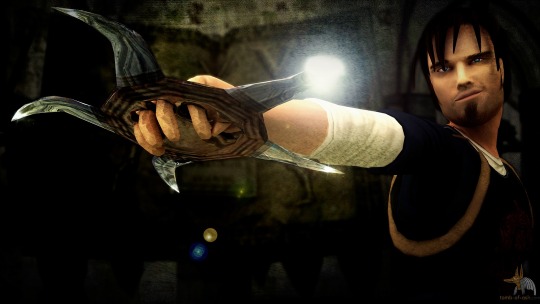
Kurtis’ life trajectory has been one of intensive training in the occult, followed by rebellion, adventure and, in the days leading up to the AOD timeline, a mission of vengeance. During his rebellious phase, he chose to exclude himself from the main areas of conflict between the Lux Veritatis and the Cabal, preferring to carve his own path through life. However, when his father was treacherously murdered, he determined to track down those responsible – in particular, the insane Black Alchemist, Pieter van Eckhardt. One way to bring this monstrous entity to retribution will be to gather all three of the Periapt Shards.
Even before taking on the mantle of dark avenger, Kurtis’ natural inclination towards extreme activities of any kind had led him to countless bizarre and exotic locations. He has worked as a freelance enforcer, problem solver, blade-for-hire, strong arm, minder, mercenary, security agent, and explorer in hot spots all around the world from North Africa to Turkey, The States and all over the European continent.
It is worth noting that, as evidenced from his Demon Hunter days in the Foreign Legion, the arcane and sinister Shadow World never truly left him alone. His LV upbringing and inherited bloodline ensured that, whatever he did, the bizarre would constantly erupt into his life. It is all recorded in his scuffed journal!
*Please note that the journal picture is a conceptual image only and the final product may be slightly different.
PRE-ORDER NOW!
#kurtis trent#lara croft#tomb raider#the angel of darkness#aod#traod#retrogaming#gamedev#gaming#game#gamers#gamer#games#videogames#murti schofield#journal
18 notes
·
View notes
Photo
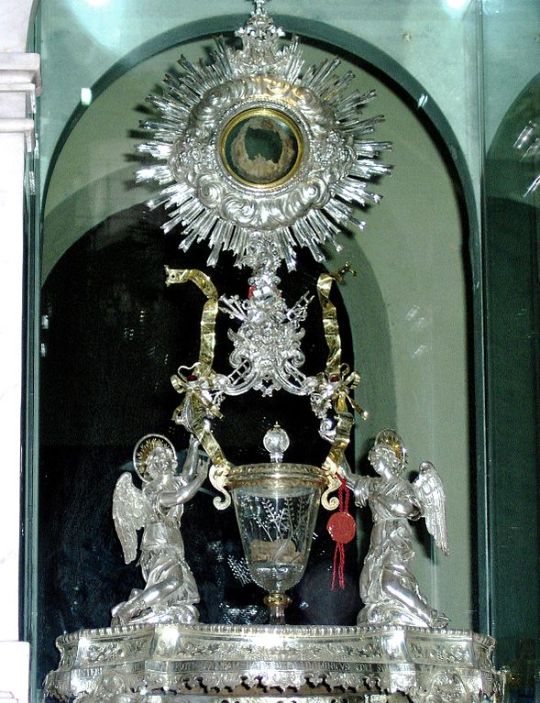
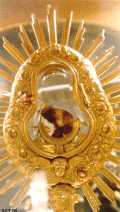
Eucharistic Miracle of Lanciano
ROME, MAY 5, 2005 (Zenit.org).- Dr. Edoardo Linoli says he held real cardiac tissue in his hands, when some years ago he analyzed the relics of the Eucharistic miracle of Lanciano, Italy.
The phenomenon dates back to the eighth century. A Basilian monk, who had doubts about the real presence of Christ in the sacred species, was offering Mass, in a church dedicated to St. Legontian in the town of Lanciano.
When he pronounced the words of the consecration, the host was miraculously changed into physical flesh and the wine into physical blood.
Later the blood coagulated and the flesh remained the same. These relics were kept in the cathedral.
Linoli, a professor of anatomy and pathological histology, and of chemistry and clinical microscopy, and former head of the Laboratory of Pathological Anatomy at the Hospital of Arezzo, is the only doctor who has analyzed the relics of the miracle of Lanciano. His findings have stirred interest in the scientific world.
At the initiative of Archbishop Pacifico Perantoni of Lanciano, and of the provincial minister of the Franciscan Conventuals of Abruzzo, and with authorization from Rome, in November 1970 the Franciscans of Lanciano decided to have the relics examined scientifically.
Linoli was entrusted with the study. He was assisted by Dr. Ruggero Bertelli, retired professor of human anatomy at the University of Siena.
Linoli extracted parts of the relics with great care and then analyzed the remains of “miraculous flesh and blood.” He presented his findings on March 4, 1971.
His study confirmed that the flesh and blood were of human origin. The flesh was unequivocally cardiac tissue, and the blood was of type AB.
Consulted by ZENIT, Linoli explained that “as regards the flesh, I had in my hand the endocardium. Therefore, there is no doubt at all that it is cardiac tissue.”
In regard to the blood, the scientist emphasized that “the blood group is the same as that of the man of the holy Shroud of Turin, and it is particular because it has the characteristics of a man who was born and lived in the Middle East regions.”
“The AB blood group of the inhabitants of the area in fact has a percentage that extends from 0.5% to 1%, while in Palestine and the regions of the Middle East it is 14-15%,” Linoli said.
Linoli’s analysis revealed no traces of preservatives in the elements, meaning that the blood could not have been extracted from a corpse, because it would have been rapidly altered.
Linoli’s report was published in “Quaderni Sclavo di Diagnostica Clinica e di Laboratori” in 1971.
In 1973, the Higher Council of the World Health Organization (WHO) appointed a scientific commission to verify the Italian doctor’s conclusions. The work was carried out over 15 months with a total of 500 examinations. The conclusions of all the researches confirmed what had been stated and published in Italy.
The extract of the scientific research of WHO’s medical commission was published in New York and Geneva in 1976, confirming science’s inability to explain the phenomenon.
Today, Linoli participated in a congress on Eucharistic miracles organized by the Science and Faith master’s program of Rome’s Regina Apostolorum Pontifical University, in cooperation with the St. Clement I Pope and Martyr Institute, on the occasion of the Year of the Eucharist under way.
“Eucharistic miracles are extraordinary phenomena of a different type,” Legionary Father Rafael Pascual, director of the congress, told Vatican Radio. “For example, there is the transformation of the species of bread and wine into flesh and blood, the miraculous preservation of consecrated Hosts, and some Hosts that shed blood.”
“In Italy, these miracles have occurred in several places,” he said, “but we also find them in France, Germany, the Netherlands, Spain ” and some in North America.
Ancient Anxanum, the city of the Frentanese, has contained for over twelve centuries the first and greatest Eucharistic Miracle of the Catholic Church. This wondrous Event took place in the 8th century A.D. in the little Church of St. Legontian, as a divine response to a Basilian monk's doubt about Jesus' Real Presence in the Eucharist.
During Holy Mass, after the two-fold consecration, the host was changed into live Flesh and the wine was changed into live Blood, which coagulated into five globules, irregular and differing in shape and size.
The Host-Flesh, as can be very distinctly observed today, has the same dimensions as the large host used today in the Latin church; it is light brown and appears rose-colored when lighted from the back.
The Blood is coagulated and has an earthy color resembling the yellow of ochre.
Various ecclesiastical investigation ("Recognitions") were conducted since 1574.
In 1970-'71 and taken up again partly in 1981 there took place a scientific investigation by the most illustrious scientist Prof. Odoardo Linoli, eminent Professor in Anatomy and Pathological Histology and in Chemistry and Clinical Microscopy. He was assisted by Prof. Ruggero Bertelli of the University of Siena.
The analyses were conducted with absolute and unquestionable scientific precision and they were documented with a series of microscopic photographs.
These analyses sustained the following conclusions:
The Flesh is real Flesh. The Blood is real Blood.
The Flesh and the Blood belong to the human species.
The Flesh consists of the muscular tissue of the heart.
In the Flesh we see present in section: the myocardium, the endocardium, the vagus nerve and also the left ventricle of the heart for the large thickness of the myocardium.
The Flesh is a "HEART" complete in its essential structure.
The Flesh and the Blood have the same blood-type: AB (Blood-type identical to that which Prof. Baima Bollone uncovered in the Holy Shroud of Turin).
In the Blood there were found proteins in the same normal proportions (percentage-wise) as are found in the sero-proteic make-up of the fresh normal blood.
In the Blood there were also found these minerals: chlorides, phosphorus, magnesium, potassium, sodium and calcium.
The preservation of the Flesh and of the Blood, which were left in their natural state for twelve centuries and exposed to the action of atmospheric and biological agents, remains an extraordinary phenomenon.
Eucharistic Miracle of Santarem, Portugal
Date of the miracle
Several historians form the XV century affirmed to have read the original document that disappeared relating the data on the miracle on February 16th 1247. Other documents related the miracle to the date of the year 1266, the registered date commissioned by King Alfonso IV is 1346. The difference in the dates could have been to the fact that the same host has been the cause of innumerable miracles in different years.
The first miracle
An unhappy woman lived in Santarem between the years of 1225 and 1247, because she was convinced that her husband was unfaithful. She tried all the possible means to bring back her husband with out any results. Desperate before her situation, she turned to sorcery visiting the soccer of the town. She promised her that her husband would again love her like before, but with the condition that she would pay her with a consecrated Host. This frightened very much the women, she knew this to be a sacrilege, but finally yield to it. After receiving communion in her parish church of Saint Stephen, she did not consume the host but left the church immediately took the host out of her mouth and placed it in her head scarf.
On her way to the sorceress house, the Holy Host started to bleed. The woman did not realized this was happening until the people passing by informed her, thinking that she was bleeding. The woman’s heart started to panic. She went home and placed the Host covered in the scarf at the bottom of a chest made of wood where she kept personal items in her room. She remained there with fear all day until night time.
When her husband arrived late that evening, they went to sleep, with the possibility that she herself did not rest much. The guilt of her sin tormented her, and also the idea that perhaps the Host continued to bleed.
In the darkness of the room, a great miracle occurred. From the chest brilliant rays of light shined through, allowing the couple to awakened. They saw a spectacular vision of angles adoring the Holy Host bleeding.
The woman no longer contained herself and confessed the great sin to her husband. Both repented and spent the rest of the night kneeling in adoration and reparation before the miraculous Host.
The next morning they informed the parish priest. He went to the house and heard the story from the woman. The priest returned the Host to the Church of St. Stephen in a solemn procession, accompanied by many priest and lay people. The host continued to bleed for three days. Finally it was decided to place the holy host (still bleeding) in a reliquary made of beeswax. The holy host remained their until a second miracle occurred.
Second Miracle (1340?)
The priest enclosed the holy host in the beeswax reliquary and placed it in the tabernacle. This is were the second miracle occurred. When the priest opened the tabernacle door, the beeswax reliquary disintegrated in small pieces. In its place was a recipient made of glass that contained the blood of the host together with the beeswax. We can contemplate it together with the main reliquary that dates from 1782. Since the XVIII century this reliquary remains in the Eucharistic throne on the mayor altar. Today it is known as the Sanctuary of the Holy Miracle.
The miracles continue
Through the centuries, the Host has bleed repeatedly and several images have been seen in the host, images of our Lord Jesus. Among the many witnesses, is Saint Francis Xavier, the missionary apostle of India who saw the sanctuary of the miracle before departing to the missions. It is known that an archbishop of Lisboa broke the glass reliquary trying to detain the bleed flow.
Blessed Sacrament Processions
Since the occurrence of the miracle until today, every year, on the second Sunday of April, the Eucharistic Miracle is taken in procession from the house where the couple lived and the miracle occurred, the Via delle Stucie to the Church of the Miracle. The house has been a chapel since 1684.
The Eucharistic Miracle of Santarem is considered the most important after the Miracle of Lanciano
Studies and canonical investigations have been made during the years, being the most important the one in 1340 and 1612, which proved without doubt the authenticity and antiquity of the Eucharistic Miracle.
Only once did the Eucharistic Miracle of Santarem leave the city, when Napoleon troops invaded Portugal in 1810. Threatened by the French and fearing the profanation, the Eucharist was taken to Lisboa, the Church of Pacao. The people of Santarem protested as time passed and the Eucharistic Miracle was not returned to them. The Eucharistic Miracle was returned in secret, to prevent resistance from the capitalians, who where not informed of the Eucharistic Miracle returning to Santarem on Dec. 2, 1811.
The sanctuary was restored by Rev. Antonio Francisco Marques, bishop of Santarem solemnly opening the doors on Dec. 7th, 1996. Today it has a small museum in the main altar. The Eucharistic Miracle of Santarem is exposed for pilgrims who request it, able to be contemplated closely. The Holy Blood has been liquified, 750 years after the miracle occurred. The old, original group (Real Brotherhood of the Sacred Miracle) in charge of safekeeping the Holy Miracle still exists today.
Popes that have granted Plenary Indulgence to the Eucharistic Miracle of Santarem:
Pope Pio IV: (1559-1565) granted Indulgence to pilgrims who visit the Church.
Pope St. Pio V and Pope Pio VI: granted privileges to pilgrims that visit the Church.
Pope Gregory XIV (1590-1591): granted Plenary Indulgence to all the members of the
Real Brotherhood of the Sacred Miracle on the day they entered the brotherhood and the day of their death.
Saints that are in some way united to Santarem and the Eucharistic Miracle
Saint Irene : Santarem in Portuguese means “Saint Irene”, patron of the city. She is a martyr of the year 653. In the Church of St. Irene we can find the Miraculous Crucifix of Monteiraz. Chuch documents relates that the Body of our Lord became alive (like the Miracle of Limpias), Jesus arm came down from the crucifix and embraced a small shepherd girl of the time of the Eucharistic Miracle. The crucifix belonged to a community of the 12 benedictine monks (Abby of 12 apostles) is from the XII century, it is still venerated today.
Saint Stephen: martyr and patron of the Church of the Holy Miracle.
Saint Leonor Alfonso : daughter of the King D. Alfonso, who became a religious of the order Poor Clares and is buried in the Monastery of Santarem.
Saint Francis Xavier: visited most of the sanctuaries of Portugal. He also visited the Church of the Holy Miracle before being sent to missions in India by the King of Portugal. St. Francis Xavier’s image is venerated in the Church of the miracle.
Saint Isabel of Portugal: most of Portugal’s Kings of that time visited the Eucharistic Miracle . The most famous visit was from two visits that Queen Saint Isabel(Isabel of Aragon), in 1295 and 1322.
Her first visit was during her trip to Coimbra coinciding with the feast of St. Irene. The second visit was to request before the Holy Miracle peace between her husband, King Dionisio and her son, the future Alfonso VI, who were in discord.
She requested the Holy Host be taken in procession in the streets. She herself accompanied the procession, deposing of her royal vestments, her crown and jewels. She covered herself with ashes, walked barefoot, with a rope around her neck. This act of penance from the Queen was very pleasing to the Lord, granting her the grace of peace and reconciliation between her husband and son.
22 notes
·
View notes
Photo


Yedocia Sino and Yedocia Greco
108 notes
·
View notes
Photo

L£S XII TRÄVÄÜX D'ÄSTÉRÏX 1976 Ç¥LÏNDRÏQÜ£ L£ G£RMÄÏÑ ÄSTÉRÏX (BÄÑD£ D£SSÏÑÉE) P∆ÑT£R∆'SH∆DØ₩ https://youtu.be/e2cSmtKo8Q0 ÏÑFØ: https://en.m.wikipedia.org/wiki/The_Twelve_Tasks_of_Asterix The Twelve Tasks of Asterix (Les Douze travaux d'Astérix) is a 1976 Belgian/French animated feature film based on the Asterix comic book series. René Goscinny and Albert Uderzo, the creators of the series, wrote the story and directed the film themselves; with co-direction by Pierre Watrin and the screenplay co-written by Pierre Tchernia, a friend of Goscinny and Uderzo. The movie was directed, produced and animated at Goscinny and Uderzo's own animation studio, Studios Idéfix and is the only Asterix animated film that has used the Xerography Process. At the time the film received polarized reviews since its tone is more cartoony and frequently breaks the fourth wall. Nowadays its reception is more favorable with it often being cited as one of the best Astérix films, even reaching the status of a cult classic. After the Gauls have defeated a group of Roman legionaries once again two of them start to wonder whether the Gauls are actually human, since their strength is so extraordinary. They start to assume that they might be gods, giving a reason to the fact why they can never be beaten. The idea is suggested to Julius Caesar who remains skeptical but decides to travel to the Gaulish village and offers their chieftain Vitalstatistixa challenge. He gives the Gauls a series of 12 tasks, inspired by Hercules (but new ones, since the 12 Labours are outdated). Vitalstatistix assembles their best warriors, Asterix and Obelix, to do the job. The Roman Caius Tiddlus is sent along with them as a guide and referee. The Twelve Tasks of Asterix Les Douze travaux d'Astérix
2 notes
·
View notes
Photo

🗣Day 11 the Extraordinary Malcolm X Born Malcolm Little in 1925, in Omaha, Nebraska, Malcolm was the son of a Baptist preacher who was a follower of Marcus Garvey. After the Ku Klux Klan made threats against his father, the family moved to Lansing,Michigan. There, in the face of similar threats, he continued to urge blacks to take control of their lives. Malcolm's father was slain by the Klan-like Black Legionaries. Although he was found with his head crushed on one side and almost severed from his body, it was claimed he had committed suicide, and the family was denied his death benefit. Its disintegration quickly followed: welfare caseworkers sought to turn the children against each other and against their mother, from whom Malcolm, then six, was taken and placed in a foster home. Mrs. Little underwent a nervous breakdown from which she never recovered. After the eighth grade, Malcolm dropped out of school, headed for a life of crime. He wore zoot suits, straightened his hair to affect a white look, and became known as "Detroit Red." When twenty-one, he was sentenced to prison for burglary and there encountered the teachings of Elijah Muhammad, leader of the Lost-Found Nation of Islam, popularly known as the Black Muslims. Muhammad's thesis that the white man is the devil with whom blacks cannot live had a strong impact on Malcolm. Turning to an ascetic way of life and reading widely, he began to overcome the degradation he had known. The argument that only blacks can cure the ills that afflict them confirmed for Malcolm the power of Muhammad's faith. He became a loyal disciple and adopted X–symbolic of a stolen identity–as his last name. After six years Malcolm was released from prison. Later, he became the minister of Temple No. 7 in Harlem, his indictments of racism and his advocacy of self-defense eliciting admiration, as well as fear, far beyond the New Yorkblack community. Whites were especially fearful, recoiling from his sustained pronouncements of crimes against his people. While most contrasted him with Martin Luther King, Jr., with whose philosophy they were much more at ease, white college students found ugly truths in his searing rhetoric (at Elagainst) https://www.instagram.com/p/B8btaaHBtkv/?igshid=1hmk2c7kfx19v
0 notes
Text
Witness borne

It’s hard to know what to do about something like the Armistice centenary; at a hundred years it’s getting quite hard to bridge the historical distance, although as someone in the region of fifty I certainly knew a few people who lived through the First World War. Reading these beautifully reprinted omnibus editions of Charley’s War turns out to be just the ticket. To honour the millions who died you need to put yourself in their shoes, and although this is not a definitive historical reference, it is brutally, heartbreakingly faithful to a carefully researched and imagined version of the ordinary, working-class Tommy’s experience.
In Brothers In Arms Pat Mills takes the opportunity to cast his net wider, and show a more diverse range of perspectives on the conflict. He is still firmly committed to the ordinary soldier’s experience (barely a page goes by without his contempt for the officer class coming to the fore), but he uses an extended meta-narrative to bear witness to the ordeal of French Foreign Legionaries, and within that tale the callous deployment of untrained Ethiopian troops to the front lines at Verdun. There is also an increased emphasis on the injustices suffered by soldiers at the hands of officers, training NCOs and the military police, with an extended treatment of the Étaples mutiny, and an even-handed, broadly sympathetic portrayal of those driven to desert. It is worth emphasising how extraordinary it was to find such an attitude in a British children’s war comic in the early 1980s.
Joe Colquhoun’s artwork is breathtaking in this volume. He marries a rigorous, well-researched, illustrative approach to buildings, clothing, vehicles and equipment, with a dynamic and expressive treatment of figures and faces. Colquhoun was a technically superb draftsman, and also a playful cartoonist, able to bring both pathos and humour to his character portrayals. These things do not make a great comics artist, of course, but he was also a master of narrative flow, and although he was an old-school artist, coming of age before a comics creator’s name would be known to their readers, his dynamic and exciting page layouts look as cutting edge as anything being produced at that time by the likes of Mick McMahon or Ian Gibson.
Before I started to read these omnibus editions, and despite my youthful exposure to this strip, I knew Charley’s War mainly by reputation. It’s becoming quite clear to me that this is one of the outstanding achievements of late twentieth-century British comics, pre-dating and anticipating the 1980s’ first flowering of the comic as a serious art-form. It is also outstanding as a cultural work in any medium, because the stories it tells, largely drawn from Mills’ extensive research, are little known; I feel that I owe it to these long dead soldiers to bear witness to their suffering, and to the shocking injustices that were heaped upon them.
0 notes
Text
** EXTRAORDINARY ** Ancient Roman bronze ** LEGIONARY ** ring - Full read by eBay
Price 33.0 USD (28 Bids) End Time: 2017-10-14 00:18:22 PDT Bid Now | Add to watch list http://ebay.to/2gA8ywG
0 notes